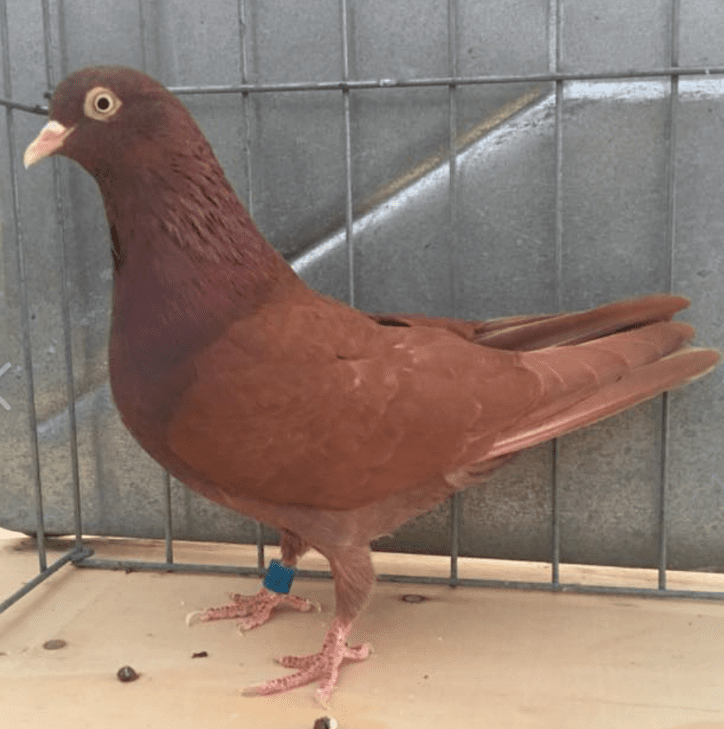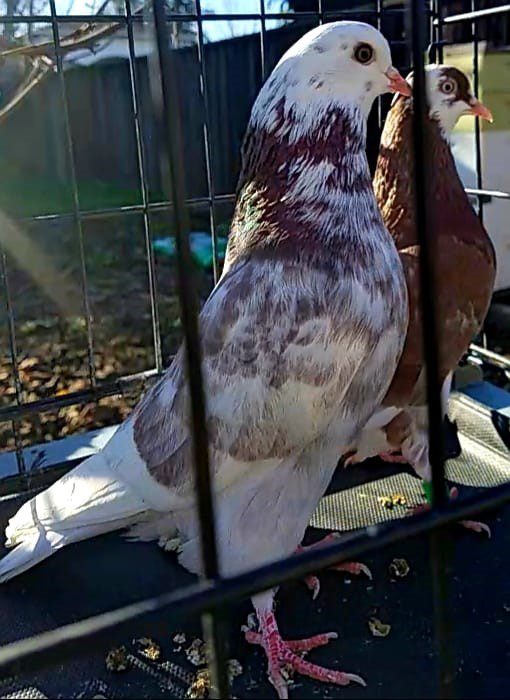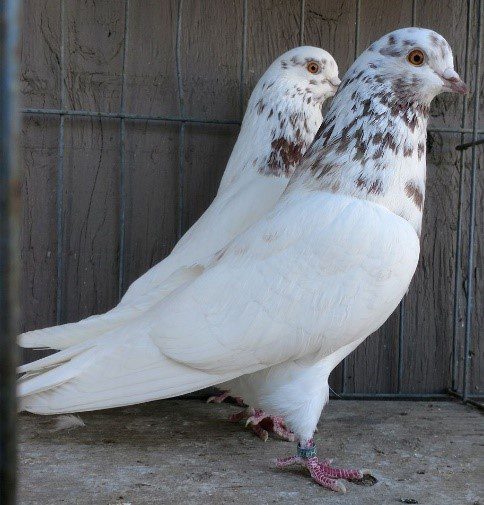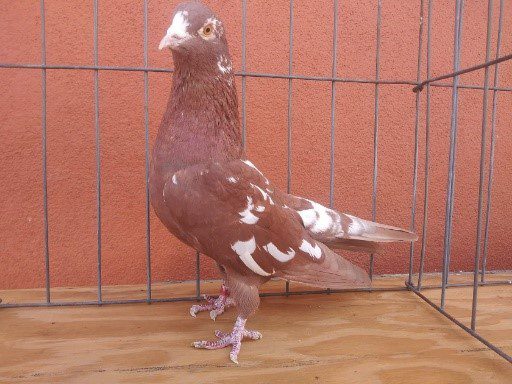Masking Factors

These masking factors all work independent of each other and there is no order of dominance, therefore you can end up with a bird having any or all of factors.
- Spread – dominant and not sex linked
- Recessive Red – recessive and not sex linked
- Grizzle – partially dominate and not sex linked
- Dilute – sex linked recessive
- Pied
- Bald Head
This young Tort has all the following factors: Grizzle, Recessive Red, Bald Head and Pied. All clearly visible on the bird. From the dark on the nape it is suspected these factors are laid down over a blue bird. This illustrates how the factors in combination can hide the base color of a roller.
Do not place any importance on the order of the masking factors I’ve listed the above, that is simply the order in which I thought to add them to my paper.
Spread
Spread takes one color and paints the entire bird that color resulting in a “self”. It is dominant so to add spread to your loft, only one bird is needed.
The most common you will think of are the solid black birds. Solid red also occurs but that will be covered more in recessive red section.
Spread across an Ash Red will give us a beautiful lavender, grey or silver – depending on who is describing the bird. Spread has taken the ash color of the tail and spread it across the entire body.
Spread is not always complete, for example in the lavenders you often end up with black ticking.
Again, to keep Spread in your loft simply mate any pair containing a solid bird and the offspring will have it.
Here we have three birds carrying spread. The first is a spread blue bar (self black). The second is a recessive red with spread and with white flights (pied/white flights is covered later). White flights is very hard to cover. The final bird is an ash red with spread.
Lavendar

A foot-note: Since the lavender rollers are actually ash-red, they breed as ash-reds – so a “lavender” hen mated to any blue or black cock will give you a sex linked mating (all ash-red cocks and all blue/black hen).
Dun
“Dun” in the roller fancy is a problem because there are two different genetic traits that are called dun. One is spread Ash Red and the other is Dilute of a spread Black.
When I asked for a picture of a dun bar, Touhoua Yang reported “Correctly, a dun bar would be a dilute blue bar or a dilute black showing bar. I think most roller guys are talking about dark ash red showing bar when they say dun bar.”
J.P. Isom reminded us “Actually if it was out of a blue bar and it was a dilute it would be called a silver bar. Dun is the dilute of a black spread.”
The two birds below are being called dun, but as you can see both carry red, so they are actually Ash Red with Spread.
An interesting foot note is that back in the 1950s and 1960s these were often called “Clay”. Regionally some flyers also refer to them as “Mahogany”.
Recessive Red
The first thing to understand is that Recessive Red is completely and totally independent of the “real color” of the bird. As Frank Mosca says think of it as a man wearing a red sweater over his shirt. His shirt could be red, it could be blue or it could be brown, but what we see on the outside is red.
Because it is recessive, both parents must have recessive red in their genetics in order to produce a recessive red offspring.
Recessive Red seems to be “weak” in that other factors such as pied or grizzle easily comes through. Our Red Mottles and Spangles are most often Recessive Reds with Grizzle. Notice the bird on the left contains just a little bit of white “bleeding though” on both it’s head and wing bows.
The solid red bird on the right is a Recessive Red with no pied or grizzle factors showing. When not affected by stronger factors it appears as though it has “spread”.
Grizzle
Grizzle is having white and another color on the same feather.
The mottle or splash is actually known as “tiger grizzle”. Note how the white flights in the red male in the middle of the lower row give it “tiger stripes”. Most roller breeders do not call it a grizzle but it is the grizzle genetics at play that produce this pattern.
Frank Mosca notes: “Spread inhibits grizzle to some extent. The reason for this seems to be that since spread adds more pigment to the feather it’s obviously working against what grizzle is doing. A spread bird carrying grizzle often shows its grizzling just about the head rather than across the whole body.” A good example of this is a pepperhead – a black bird with a few white flecks about its head.
Grizzles mated together tend to become whiter and whiter with each generation until it is possible to virtually eliminate any color.
Dilute
The first dilute that comes to mind is yellow. This is a diluted red. Dilute works on both reds – Ash red and recessive red but yields different looking results.
To those of us who are not geneticists think of this as being the last factor that is applied to a bird and it dilutes any color that has been laid down on the bird. For example, if our bird a red mottle and we apply dilute then it would end up being a yellow mottle.

The bird on the right is a yellow “baldie”. Later we cover the pied and baldhead traits in the birds, but here we are discussing dilute. This bird is gentically red but because it carries the dilute gene it is yellow.
The bird on the left is not part of this discussion at all (it’s a grizzle).

These two self yellows are dilute recessive reds. The recessive red covers the entire bird and then the dilute reduces the color to yellow. Because there are no other factors such as pied, these birds are all yellow or “self”.

This cream bar is genetically a red bar with dilute. Often when you see dilute on the ash-reds they are called cream and dilute placed on recessive red is called yellow because of the difference on the richness or intensity of the color. The cream is a more muted yellow color. This is not to say that this is a hard and fast rule as some call both yellow and some call both cream.
Pale
I am hesitant to include anything “rare” in this document as most rare things are not, they are simply misunderstandings of the general rules or combinations of other factors. However, in this case it is warranted.
The Casperson family of rollers have been Reds, Blacks and Yellows since sometime around 1825. One family was Mottled, another became Solid Selfs, another fellow made them into White-Sided Selfs and the group I got from Ray have been Badge Selfs since about 1940.
The problem is that a yellow mated to a Black NEVER produces a diluted black (dun). According to the rules of dilution that should be happening and yet you can mate the Caspersons anyway you want and they simply do not throw any other color or pattern.
Frank Mosca and J.P.Isom believe that what we are dealing with is not the typical “dilute” but rather the more rare “pale”. Pale on a Recessive Red gives you Gold. Pale on a Black gives you Black! Yes, the black is ever so slightly different but so little so that it is almost impossible to detect with the naked eye. So, the Caspersons I have are all Homozygous Spread with Badge Pied markings and carry the Pale factor. That is why they breed true to these three colors ff
To summarize, the dilute series is pale, dilute and extreme dilute. Think of it as pale being a 25% reduction in color, dilute is 50% reduction in color and the extreme dilute is 75% reduced. These numbers are not exact, simply a way to think of their effect on the base color.
The pale on recessive red is known as gold because it is a much deeper, richer and redder color in the yellow spectrum.
As a side note, the dilutes have short down when hatched but the pale squabs down length is almost no different from the down on regular squabs.
Pied
It has been written that pied is one of the most complex and least studied of the genetic traits in pigeons.
Pied is basically white feathers in a group somewhere on the body of the bird. That would include white flights, white sides, baldies, badges, bearded, etc.
Bald Head
Bald heads are a pied pattern that has been ‘fixed”. Some definitions require the baldie to have both white flights and white tails while others do not. As the bald head is not a stand along gene but apparently a mixture it is possible to get it in many forms, shapes and sizes. It does not appear to be genetically linked to other patterns or colors.
White Sides
Another variation of pied are the “white sides”. Throughout history several flocks have been established that fixed the white sides in their line. As stated earlier the pied genetics are not completely understood and it may be that the white side is a stand alone trait but it is unknown at this time.
Generally “white sides” are nothing more than white wing bows on a colored bird however as you can see from the pictures there are variations on this including entire wings that are white. When combined with tiger grizzle, there may be some stray colored feathers on the white shield.
This pied trait that creates white sides appears to be somewhat dominant as it can quickly overwhelm a loft.
Badges
The final example of a pied masking factor that has been stabilized is the badge.
Badge is a pattern that has been fixed in some families. It is another variation of the pied factor. Usually badge refers to a bird with a little white on its face/throat and white flights but a colored tail. However, not all breeders agree that a badge should have a colored tail. Some even suggest a badge should be a self-colored (solid color) but that is not universally accepted.
To confound the issue the second bird may also be called a “beard” because the white below the beak is such a narrow stripe. Different regions use different terminology and this has created some confusion for the beginner.



































